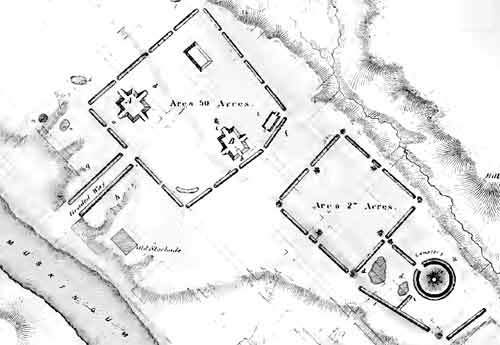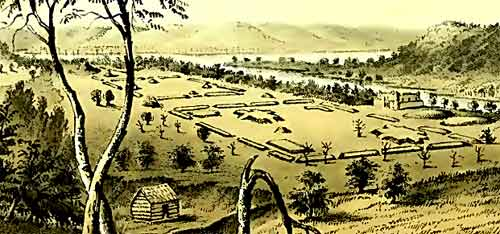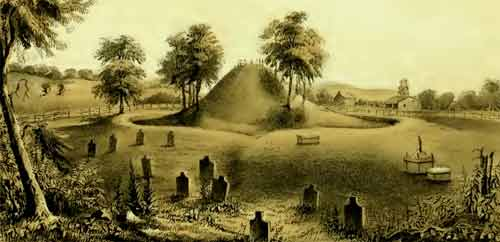Illustration from Squier and Davis' "Ancient Monuments of the Mississippi Valley"
Marietta Earthworks
When the first flatboat of Ohio Company of Associates landed at the mouth of the Muskingum River and the Ohio River in 1788 they found an extensive complex of earthworks above the banks of the Muskingum River. They didn't know what these series of earthworks and mounds meant, or who created them. What they did realize was this was a good place to build their first settlement: Marietta. Perhaps in time, when they became friendly with the Native Americans in the area, they would find some answers.
The site intrigued the new arrivals and Rufus Putnam almost immediately began surveying the site. When Rev. Manasseh Cutler arrived in Marietta the following year, he too was impressed. As an avid botanist, he ordered several trees growing out of the earthworks should be cut down so as to count the annual growth rings. In 1788 it was determined that these trees were 441 years old so that the tree dates back to 1347. At that time there was much discussion as to the origins of the many earthworks found on the western frontier. By assuming that the builders of the earthworks would not have allowed a tree to disturb their structure, it could then be surmised that the mounds were here long before Christopher Columbus.

1837 Survey of the Marietta Earthworks Complex. The Muskingum River is in the lower left corner and the large conical mound is in the lower right corner.
When Rufus Putnam first set foot here, the Marietta Earthworks as they would be called, had one very large conical mound at the extreme southern end of the complex. Although they didn't understand what they were seeing, they decided it was important that they preserve the major features. And this lasted almost 100 years.
In 1882 the graded road leading down to the river was dug up with the construction clay being used for bricks. This process also laid claim to most of the earthworks walls.

Illustration of the Marietta Earthworks as it appeared to early settlers. The Muskingum River is on the right side and the Ohio River and West Virginia are in the background.
The Marietta Earthworks represented a combination of all 3 Mound Building cultures: Adena, Hopewell and Fort Ancient. The prominent large conical mound is directly related to the early Adena Culture. Most of the earthworks were constructed by members of the Hopewell Culture, and a few defensive positions seem to indicate that the Fort Ancient culture also lived here.
The Hopewell structure is slightly modified compared to other Hopewell sites found throughout the state. The Marietta site more closely resembled Hopewell sites found in more southern areas of the North America, particularly around the Mississippi Valley.
 The Marietta Earthworks also had 3 basic enclosures. The largest on the north end of complex featured a rectangular enclosure with what may have been a ceremonial walled pathway leading down to the Muskingum. Inside this enclosure were 2 massive elevated mounds that looked like platforms with ramps leading up to the top on each side. The larger truncated pyramid was named Quadranaou and the next largest was called Capitolium. There were several other elevated platforms but not as large.
The Marietta Earthworks also had 3 basic enclosures. The largest on the north end of complex featured a rectangular enclosure with what may have been a ceremonial walled pathway leading down to the Muskingum. Inside this enclosure were 2 massive elevated mounds that looked like platforms with ramps leading up to the top on each side. The larger truncated pyramid was named Quadranaou and the next largest was called Capitolium. There were several other elevated platforms but not as large.
The Quadranaou illustrated at left, was 180' long by 32' wide and 10' high. Midway on each side were graded ascents to reach the plateued top. These grades were 25' wide and 60' long. The Capitolium was similarly constructed except smaller in size and with only 3 ramps. Although smaller in size, it had a more commanding view of the enclosure due the lay of the land.
The middle enclosure consisted of just an enclosure with 4 mounds, each one located at the midpoint at each of the 4 walls

The large conical mound is 30' high and it is enclosed by a low circular wall and an interior ditch. Today, the large conical mound named "Conus" is the only intact surviving element of the Marietta Earthworks. Located in the middle of Mound Cemetery, Conus has steps that allow visitors to climb to the top where there are benches to sit and admire the view.
The truncated pyramidal mound called Capitolium still exists, but the Washington County Library is built on top of it. The Quadranaou Mound has also been preserved and is located in Quandranaou Park. In 1990 a small portion of the Capitolium was excavated by the Cleveland Museum of National History. The results of this excavation is that the mound definitely belongs to the Hopewell Culture.



